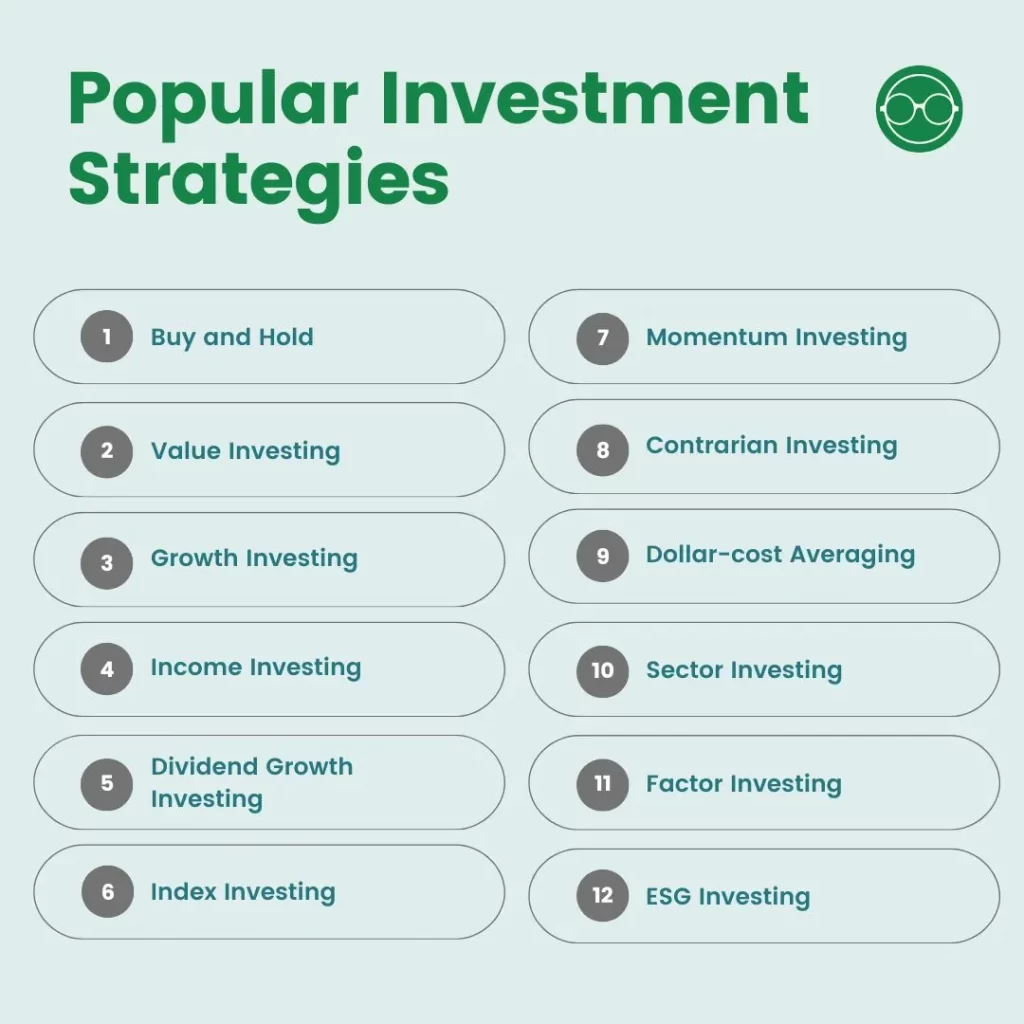This post may contain affiliate links. We may receive compensation when you click on links to those products at no additional cost to you. Read our full disclosure here.
Investing can be overwhelming, especially when faced with an abundance of options. It can be difficult to determine which investment is right for you, and the fear of making the wrong decision can lead to analysis paralysis. This is a common problem faced by many investors, both new and experienced.
The good news is that there are various investment strategies that can help simplify the decision-making process and help you make informed decisions that are tailored to your unique goals and objectives.
In this article, we will explore the investment strategies that every investor should know about.
Understanding Your Investment Goals and Risk Tolerance
Before selecting an investment strategy, it is crucial to first understand your investment goals, time horizon, and risk tolerance as that will dictate which investment strategy will work best for you.
- Investment goals are what you want to achieve through investing, such as buying a house, retiring comfortably, or generating passive income.
- Your investment horizon refers to the length of time you plan to hold your investments. For instance, if you’re saving for retirement, your investment horizon may be several decades.
- Risk tolerance is the level of uncertainty or potential loss you are willing to accept in pursuit of your investment goals. It’s important to understand your risk tolerance before investing to avoid making emotional decisions or taking on too much risk.
Read here to learn more about Understanding Your Investment Goals and Risk Tolerance.
Once you have an idea of what your goals and risk tolerance are, let’s dive into the various investment strategies!

Buy and Hold Strategy
First up, we have the buy-and-hold strategy. The buy-and-hold investment strategy involves buying an investment and holding it for an extended period, typically ten years or more. The idea behind this strategy is to allow your investment to grow over time, taking advantage of the power of compound interest.
Pros
- Less trading activity and associated costs.
- Takes advantage of the power of compound interest.
- Encourages a long-term perspective.
Cons
- May miss out on short-term gains.
- Exposes investment to long-term market risks.
- May require patience and discipline to hold on to investment during market volatility.
Value Investing
Value investing involves buying stocks that are undervalued by the market. The idea behind this strategy is to find companies that are trading at a discount to their intrinsic value, allowing investors to buy them at a lower price and sell them for a nice profit when the market corrects.
Value investors typically use fundamental analysis to find investments that are undervalued. This includes researching a company’s financial statements, earnings history, competitive landscape, and other factors to evaluate a company’s present value through a discounted cash flow (DCF) approach or a multiple approach.
If the investment is priced lower than the calculated present value of the stock, the investor will buy it. However, you need to do your due diligence and ask yourself why is the company undervalued and why other people are not acting on it if it is public information especially stocks that have been “undervalued” for long periods of time.
Pros
- Potential for high returns.
- Opportunity to buy quality companies at a lower price.
Cons
- Requires significant research and analysis.
- Can take time to realize profits.
- Risk of investing in companies that never increase in value.
Growth Investing
Growth investing is a strategy that involves investing in companies that have a high potential for growth. The idea behind this strategy is to invest in companies, sectors, and industries that are growing rapidly in terms of size, revenue, and profits and is forecasted to continue growing in the future.
In terms of valuation, growth companies are typically more “expensive” as investors are willing to pay a premium for potential. However, if the growth potential is not realized or if there is a change in narrative, the growth investment can also decrease in value quickly as well to reflect the new expectations.
Thus, it is important to be clear on what the drivers of growth are and whether the growth potential is driven by external factors (like interest rates), or truly because of the company’s potential.
Pros
- Opportunity for high returns if the company continues to grow.
- Investing in innovative and potentially disruptive companies that have a lot of growth potential.
Cons
- Higher risk due to investing in companies with unproven track records.
- Stock prices may be overvalued, leading to potential losses.
- May take time for the company to realize its full potential and generate profits.
Income Investing
Income investing is a popular strategy among investors looking for a consistent and stable source of income. The approach involves investing in assets that generate regular income streams, such as dividend-paying stocks, bonds, or real estate investment trusts (REITs).
Investors who use income investing as their strategy often focus on the income generated by their portfolio on top of the potential for capital gains. By focusing on income, investors can generate a stable cash flow to supplement their income or reinvest for further growth.
Pros
- Provides a steady stream of income.
- Can be less risky than other investment strategies.
- Allows for portfolio diversification.
- Can be a good option for those who need regular income, such as retirees.
Cons
- Returns may be lower than other investment strategies.
- Inflation can erode the value of income over time.
- Limited potential for capital appreciation.
- Less control over the timing of cash inflow.
- Some income-generating investments may be sensitive to interest rate changes.
Dividend Growth Investing
Dividend growth investing is a long-term investment strategy that focuses on selecting stocks of companies with a consistent history of increasing and growing dividend payments to their shareholders.
Investors who employ a dividend growth investment strategy typically seek out companies with:
- Strong financials
- Stable cash flows
- A proven track record of growing dividends year after year
- The S&P 500 Dividend Aristocrats is a good list of companies that have paid and increased their base dividends for the past 25 years.
By reinvesting the dividends received from these stocks, investors can compound their returns and potentially achieve significant wealth creation over the long term. Dividend growth investing can be a recipe for the best of both worlds for those looking for a steady stream of income and long-term growth potential.
Pros
- Potential for a steady stream of income through regular dividend payments.
- Provide a sense of security as these companies are typically strong financially.
- Can lead to long-term wealth accumulation through reinvesting dividends and compounding growth.
- Can provide some protection against inflation.
Cons
- Can limit opportunities for capital appreciation compared to growth investment strategies.
- Reliance on dividend payments can lead to a potential loss of income if a company reduces or suspends its dividend.
- Heavy focus on dividend yield can lead to overlooking other important factors, such as company fundamentals and growth potential.
- Can require patience and a long-term perspective, which may not be suitable for all investors.
Index Investing
Index investing is a passive investment strategy that seeks to replicate the performance of a specific market index, such as the S&P 500 or the Dow Jones Industrial Average. The goal is to achieve returns that closely mirror the overall market while minimizing fees and avoiding any active risks associated with active management.
One can easily implement an index investment strategy by using mutual funds and ETFs. For example, funds that track the S&P 500 index include the VOO (ETF) and FXAIX (index fund).
Pros
- Low fees and expenses
- Diversification across a broad range of assets
- Reduced risk compared to investing in individual stocks
- Passive management style requires less time and effort
Cons
- Limited upside potential compared to individual stock picking
- Potential for losses during market downturns
- Lack of control over specific investments within the index
- May not align with personal investment goals or values
Momentum Investing
Momentum investing is a strategy where investors buy assets that have shown strong performance in the recent past, with the expectation that this trend will continue in the near future.
The idea behind this strategy is that assets that have performed well in the past are likely to continue to do so, at least in the short term, due to various factors such as positive news or market sentiment.
To implement this strategy, investors typically screen assets based on their recent performance, such as price changes over the past 6-12 months, and select those that have outperformed the market or their peers. They then buy these assets and hold onto them for a certain period, such as several months, until the momentum dies or when the trend changes.
Pros
- Potential for high returns in a short amount of time
- Can be easily implemented using quantitative models
- Can take advantage of market trends and shifts
Cons
- Can be risky and volatile, leading to significant losses
- Requires constant monitoring and adjustment
- May not perform well in stable or stagnant markets
- Does not consider company fundamentals
Contrarian Investing
Contrarian investing involves going against the market trend by investing in undervalued or out-of-favor stocks. The idea behind this strategy is that, over time, the market will eventually recognize the true value of the investments, and the contrarian investor will be able to profit from the price correction.
Contrarian investors look for companies with:
- Temporary setbacks
- Undervalued metrics
- Negative news events
Successful implementation of this strategy requires a good risk management strategy especially if your investment thesis is proven to be wrong.
Pros
- Can lead to significant gains if the contrarian call is correct
- Provides opportunities to buy assets at a discount
- Can help diversify a portfolio by investing in unloved or unpopular assets
Cons
- Can be risky as it involves going against the prevailing market sentiment
- Requires a deep understanding of the asset being invested in and the reasons why it is currently unpopular
- Timing is crucial in contrarian investing, and it can be difficult to determine the right time to enter and exit the market.
Dollar-Cost Averaging
Dollar-cost averaging (DCA) is an investment strategy that involves regularly investing a fixed amount of money into a particular investment over a period of time, regardless of the asset’s price.
The goal is to take advantage of the volatility of the market by buying more shares when prices are low and fewer shares when prices are high, thereby reducing the overall average cost per share.

DCA can help reduce the risk of investing a large sum of money all at once before markets fall. With DCA, investors can spread out their investments over time and potentially reduce the impact of market volatility on their overall investment returns.
Pros
- Reduces the impact of market volatility as investments are made at regular intervals, regardless of market conditions.
- Helps avoid the temptation to time the market, as investments are made regardless of short-term fluctuations.
- Allows for a disciplined approach to investing and encourages long-term thinking.
- Can result in lower average costs per share over time.
Cons
- May not result in maximum returns, as investments are made at regular intervals rather than when the market is at a low point.
- Requires regular contributions, which may not be feasible for all investors.
- DCA historically underperforms lump-sum on a risk-adjusted basis.
Sector Investing
Sector investment strategy involves focusing on specific sectors or industries within the stock market rather than investing in individual stocks or a broad market index. This strategy allows investors to target areas of the market that they believe have the potential for growth or that align with their personal values and interests.
Sector investing can be achieved by buying individual stocks within a sector or by investing in exchange-traded funds (ETFs) or mutual funds that are focused on a particular sector. ETFs and mutual funds offer the benefit of diversification within the sector, which can help reduce risk.
Pros
- Allows for focused investment in a particular industry or sector
- Can potentially lead to higher returns if the sector performs well
- May provide a hedge against risks or opportunities specific to a sector
Cons
- Higher risk due to lack of diversification
- Vulnerable to downturns in a specific industry or sector
- Requires knowledge and expertise in the specific industry or sector, which may be time-consuming to acquire
Factor Investing
Factor investing is an investment strategy that involves selecting stocks based on specific characteristics, or factors, that are believed to drive returns above the total stock market. Factors can include measures such as company size, value, momentum, quality, and volatility.
The idea behind factor investing is that certain factors like the ones listed above have historically outperformed the general market over long periods of time. By having portfolio exposure to these factors, investors can potentially achieve higher risk-adjusted compared to just investing in the total stock market.
To implement a factor investment strategy, investors can use a variety of approaches such as creating custom portfolios based on factor scores, selecting stocks from factor-based indexes, or using factor-based mutual funds or exchange-traded funds (ETFs).
Pros
- Offers the potential for higher returns than traditional market-cap-weighted index funds.
- Diversifying across different factors can reduce overall portfolio risk.
- Based on sound academic research and a long-term investing philosophy.
- Can be customized to fit individual investor’s risk tolerance and investment goals.
Cons
- Requires a deeper understanding of financial markets and investment strategies.
- Can be difficult to implement for individual investors without the assistance of a financial advisor.
- Requires patience and discipline, as factor returns may take time to materialize.
- Factors may not work as usual in a change of regime.
ESG Investing
Environmental, Social, and Governance (ESG) investing is an investment strategy that involves investing in companies that are good for the environment, have a positive impact on society, and have strong corporate governance. ESG investors may also choose to exclude certain companies that do not align with ESG principles in their portfolio.
ESG investing is great for those who want to invest based on their values and beliefs. For example, some investors may not want to invest in funds that hold tobacco companies due to personal values. There are also many ESG funds and ETFs that investors can pick from based on what they value.
Pros
- Addresses social and environmental concerns by investing in companies with good environmental, social, and governance (ESG) practices.
- May help reduce risk by avoiding companies with controversial practices or poor governance.
- Aligns with personal values and beliefs, allowing investors to make a positive impact through their investments.
Cons
- May result in lower returns due to limitations on available investment options.
- Lack of standardization in ESG metrics and ratings can make it difficult to evaluate the effectiveness of the strategy.
- May not have a significant impact on addressing social and environmental issues as it only focuses on selecting companies with good ESG practices rather than actively engaging in advocacy or policy change.
Conclusion
Investing is an important aspect of building wealth and achieving financial independence. However, it can be overwhelming for those who are new to the world of investing. Understanding the investment strategies discussed in this article can help investors make informed decisions and remain disciplined in investing.
Remember that no investment strategy can guarantee a profit, and there will inevitably be ups and downs along the way. Be sure to do your own research and consult a financial advisor before going in on an investment strategy!
FAQs
What is the best investment strategy for beginners?
The best investment strategy for beginners depends on their investment goals and risk tolerance. For beginners, a long-term investment strategy, such as index investing or dollar-cost averaging, can be a good place to start.
What is the difference between value investing and growth investing?
Value investing involves buying undervalued stocks, while growth investing involves buying stocks in companies with high growth potential.
Can I combine different investment strategies?
Yes, you can combine different investment strategies to create a portfolio that aligns with your investment goals and risk tolerance.
What is the advantage of index investing?
The advantage of index investing is that it provides diversification and low fees, allowing investors to achieve returns that are similar to the market average.
How often should I review my investment portfolio?
It is essential to review your investment portfolio regularly, at least once a year, to ensure that it still aligns with your investment goals and risk tolerance.
This post may contain affiliate links. We may receive compensation when you click on links to those products at no additional cost to you. Read our full disclosure here.






